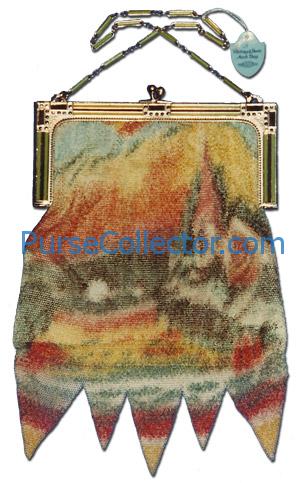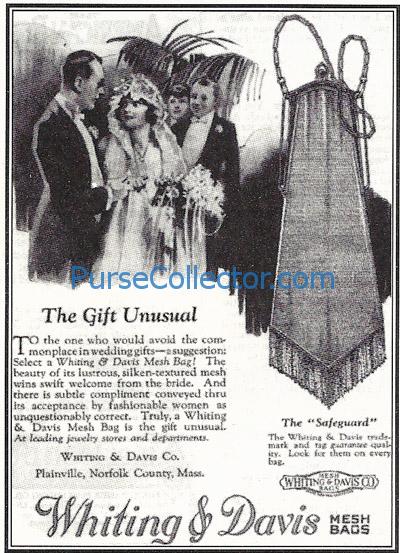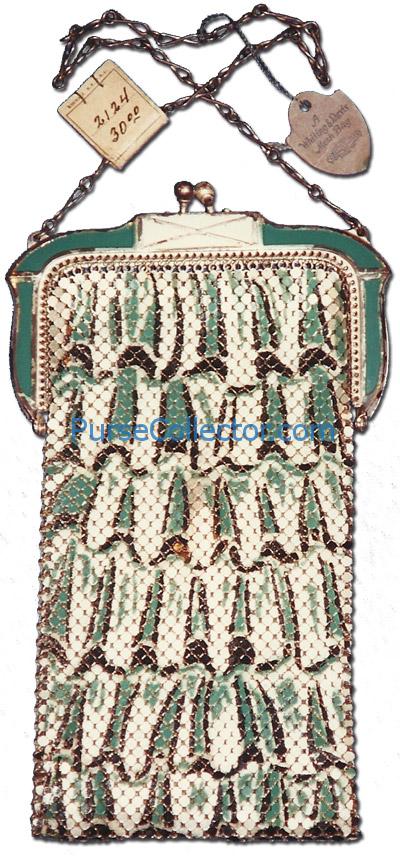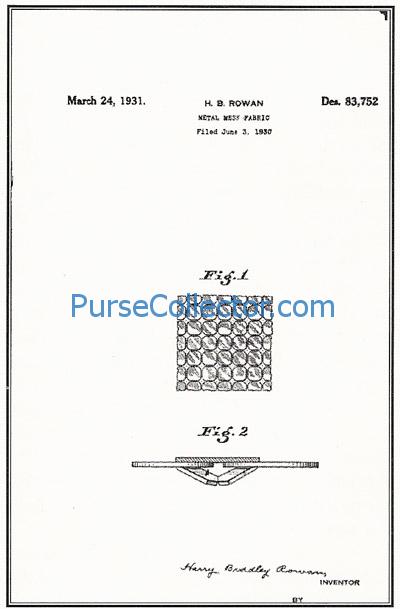



How can mesh bags be dated? Do different bag shapes or styles of mesh give any hints? When did painted mesh bags first appear and how much did they cost? What is Ivorytone mesh? These are just a few of the questions asked by antique enthusiasts and purse collectors. Many of these mysteries about mesh bags can be answered by following a trail of information presented in vintage ads, patent documents and old catalogs. Beautiful bags with striking, colorful designs made during the 1920s and early 1930s are the ones that fascinate so many of us. Much has been written about them in the past few years, yet there are still many enduring mysteries about these bags in the minds of those who admire and collect them. While there were several other foreign manufacturers and important manufacturers that contributed substantially to the development of the mesh purse industry in the U.S., including — Bliss (later Napier), Evans Case Company, Mandalian Mfg., R&G Company (later Ripley & Gowen), The Thomae Company, and Theodore W. Foster & Bro. Company (F&B) — Whiting & Davis of Plainville, Massachusetts, produced mesh purses in the greatest variety of mesh types and bag styles. Consequently, documents pertaining to Whiting & Davis bags afford the most solutions to the mysteries of mesh.


The trail of clues leading up to the introduction of painted mesh bags begins with the appearance of plain ring mesh around the turn of the century. The earliest mesh bags were made of individual metal rings, which were connected by hand. Charles Whiting, later to become president of Whiting & Davis, developed his first handmade ring mesh bag in 1892. Another type of mesh called flat mesh or fish scale mesh appeared around 1900. It consisted of a series of cruciform links called spiders that were joined by metal rings. During this time many companies produced handmade mesh bags. However, making mesh and mesh bags by hand was very slow. No single company was able to produce enough bags to supply the market on a national scale.
In 1909, under the direction of Charles Whiting, A.C. Pratt invented the first automated machine for making ring mesh fabric. Pratt also invented a similar machine for making flat mesh in 1913. These patented machines gave Whiting & Davis a decided advantage and probably hastened the demise of many of its competitors more than any other factor. Following this development, the number of companies producing mesh bags gradually began to dwindle. After further refinement and improvement in the productivity of mesh machines, Whiting & Davis finally had the means to produce large quantities of these popular and affordable fashion accessories.
The uniqueness of a flexible fabric of metal was the basis for the appeal of these early mesh bags. However, the demand of the fashion world was for constant change. Originality and variety were two of the forces that drove the industry. Whiting & Davis designers were constantly attempting to meet that challenge by introducing new features and by altering the appearance of the bags. They concentrated on changing the shape of the bags and frames and adding ornamental devices and gimmicks to maintain the public’s interest in the product. The “Safeguard” was one of those gimmick purses promoted in a 1921 ad. Although it had an effective snap closure, the frame was also pierced on the sides so that rings attached to the chain handle would slide up and down the pierced section. The idea was that while the lady was holding the chain handle and the bag was suspended, the purse could not be opened.

In 1922 a vanity bag, the “Picadilly”, was advertised featuring a miniature compact with a convex mirror built into the purse frame. It’s hard to imagine that the tiny mirror was very useful, but it was novel.


A more practical purse, the “Dansant”, was introduced in 1923. This interesting design incorporated two bags on one strap that could be tightened around the lady’s wrist while she was dancing.

During this period, there were also attempts to plate the mesh and impart finishes of different colors. The most popular of these experiments may have been “Sunset Mesh,” a combination of three mesh colors in one purse. Several ads in various magazines promoted Sunset Mesh bags as gifts for Christmas in 1922. Originally Sunset Mesh was made by using three different types of metal employing a complex and costly process. Later, in 1925, a less expensive method of producing the same effect was patented. Using this new method, one type of metal fabric was subjected to different chemical baths. By this time, however, another technique had been developed to capitalize on the popularity of colored mesh.
In 1924 the most significant development in mesh purse design took place. Whiting & Davis began to sell mesh bags with all-over painted designs. Virtually all of the earlier Whiting & Davis ads were for ring mesh bags. However, in 1924, designers used the new painting technique to apply color to flat mesh. No longer did mesh bag designers have to rely solely on bag shape, frame design, or gimmicks to maintain interest in the product. The focus of bag design turned to color and aesthetic appeal of the painted designs on the mesh. The earliest advertisement we have found for painted mesh bags is dated October 1924. The earliest reference to painted mesh bags is found in a June ad of the same year, although the bags themselves are not pictured. Conflicting reports have placed the introduction of painted mesh bags as early as 1921, but it seems unlikely. None of our collection of over thirty ads, dated 1921 through May 1924, makes any mention of painted mesh bags. This information leads us to believe that painted mesh bags were introduced in the spring of 1924, although it wasn’t until August 1927 that Whiting & Davis filed a patent application for painting mesh fabric.

The earliest Whiting & Davis all-over painted mesh bags were called “Tapestry Mesh” and had very basic geometric designs. A characteristic that we have observed about these early bags is that many have colored beads interspersed with the links of the chain handles. This feature may not have been present on all early painted bags, but it was frequently used as a decorative device.

With the arrival of painted mesh, designers did not give up their pursuit of other ways to bring novelty to mesh purses. Charles Whiting himself invented one of the most interesting decorative devices. Although much was done with various shades of paint to create depth in the designs, the single plane of the flat mesh bag was a difficult medium in which to create perspective. Apparently it occurred to Mr. Whiting to solder some of the links together and press the soldered links in a die, thus creating a form in relief. This made for a very interesting three-dimensional effect, most often in the shape of flowers. Appropriate colors were then applied to the resulting soldered mesh form to complete the floral design.


When painted mesh bags appeared in ads in 1924, they were made from flat mesh, and there was no mention of painted ring mesh bags. It wasn’t until three years later that painted ring mesh bags were introduced. The success of painting flat mesh bags undoubtedly led Whiting & Davis to try painting ring mesh bags. By 1926, Whiting & Davis had perfected a method for painting ring mesh bags, and the new line of bags was introduced that spring. The earliest ad we’ve found for painted ring mesh bags appeared in October 1927. Ironically, the black and white ad proclaims “The First Flash of Autumn Color” and goes on to introduce painted ring mesh. Ring mesh did not accept painted designs in the same way as did flat mesh. The designs took on a hazy appearance similar to Impressionist watercolor paintings. Painted ring mesh bags made of the very smallest diameter ring mesh became known as Dresden mesh purses.


Prices were much higher for painted ring mesh bags than flat mesh bags of similar size. In the 1928 catalog of the wholesale jeweler A.C. Becken Co. of Chicago, one of the 5” painted ring mesh bags is listed at a retail price of $42. In the same catalog the most expensive 5” flat mesh bag lists for $18. It is not reported in any of the material we’ve found how well accepted painted ring mesh bags were. However, given the higher prices, we suspect that not as many were sold. They did not wear as well as the painted flat mesh bags, so even fewer pieces have survived in good condition to find their way into today’s collections.

In 1929, “Beadlite” mesh was patented, although the patent had been applied for on March 2, 1928. The inventor was Sturgis Rice, who later became president of Whiting & Davis from 1940 to 1960. Beadlite mesh is similar to flat mesh except that in the center of the spider there is a rounded projection. Actually, Beadlite must have been developed earlier because bags of this type appear in 1928 jewelers’ catalogs which would have gone to press in 1927. Another patent, this one issued to Richard Berkley and assigned to Whiting & Davis in 1927 (filed in March 1926), was for a machine to produce a type of mesh very similar to Beadlite. Beadlite bags appeared in the same catalogs at the same time as painted ring mesh. Our conclusion is that the first Beadlite bags appeared in the fall of 1927. Like painted ring mesh, little is known about how well Beadlite bags were received by the public. Although they were priced comparably to flat mesh bags they did not seem to hold the same aesthetic appeal.


In a renewed effort to stay abreast of fashion demands, Whiting & Davis employed the services of Paul Poiret, a well-known French fashion designer of the 1920’s and 1930’s. His association with Whiting & Davis ushered in a new era of mesh handbags with a distinctive pouch shape. The new pouch shaped bags were made in flat mesh, Beadlite, and ring mesh and featured Deco frames and colorful Deco designs on the mesh. The exact date “Poiret Bags” were announced to wholesalers is a matter of record. In a dramatic full-page ad in the June 6, 1929 issue of The Jeweler’s Circular, the headline reads, “Mr. C.A. Whiting cabled from Paris: Announce the new Paul Poiret pouch-shaped costume bags June 1st.” Collectors today see comparatively few of the painted mesh Poiret bags, as they came toward the end of the era when mesh bags featured painted designs.

“Ivorytone”was another type of flat mesh that coexisted with original flat mesh, Beadlite and Dresden ring mesh. Evidently the name was not given for the color of the mesh, since it appeared in all colors just as did the original flat mesh. How the name Ivorytone was chosen remains one of the unsolved mysteries of mesh. Harry Rowan, one of the most prolific designers on the Whiting & Davis staff, invented Ivorytone mesh. He filed for a patent on the new mesh in June 1930, and the patent was issued on March 24, 1931. The principal characteristics of Ivorytone mesh that set it apart from the original flat mesh are the shape of the spider and the proximity of the spiders to each other. Original flat mesh spiders are cruciform in shape and spaced further apart than Ivorytone spiders. The shape of Ivorytone spiders can be best described as square with clipped or rounded corners. The surface that Ivorytone presented was even better and allowed for a more uniform appearance in the painted design. Consequently, Ivorytone mesh eventually became the standard form of mesh used in bags. Keep in mind that metal mesh bags with painted designs were, like so many other fashion trends, only around for a short time. Beadlite, ring mesh, and Ivorytone arrived later in the painted mesh bag era. Ivorytone’s debut came toward the end of this period, and therefore fewer of these bags are available to today’s collectors.


By 1933, jewelers’ catalogs were still showing painted mesh bags, but ads for them in periodicals had all but disappeared. The timeless appeal of mesh remained, and the bags evolved with the dictates of fashion, but mesh bags with painted designs faded from the scene.

Some of the mysteries of mesh have been explored and still others remain. There are gaps in the trail of clues and some of the conclusions we’ve reached could be proven wrong with a single piece of new evidence. We hope the information we’ve presented leads you to solve other mysteries of mesh and inspires a better understanding of these exciting metal mesh bags.
